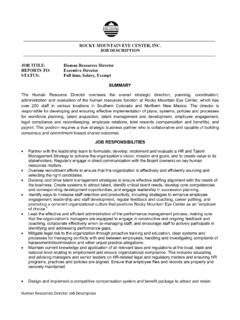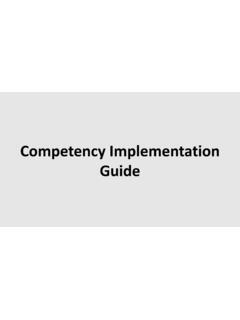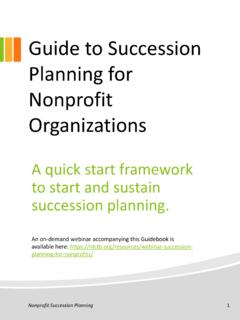Transcription of MENTORING GUIDE
1 MENTORING GUIDE A GUIDE for Mentors Center for Health Leadership & Practice A Center of the Public Health Institute ii MENTORING GUIDE A GUIDE for Mentors Center for Health Leadership & Practice Public Health Institute Oakland, CA November 2003 This MENTORING GUIDE is based on materials originally developed by the Center for Health Leadership & Practice, Public Health Institute, for the State Health Directors Executive MENTORING and Consultation Program of the State Health Leadership Initiative (SHLI). The SHLI is administered by the National Governors Association with funding provided by the Robert Wood Johnson Foundation. iiiAbout the Author The Center for Health Leadership & Practice (CHLP), a Center of the Public Health Institute, is based in Oakland, CA. CHLP has been engaged in leadership development enterprises (international, national, and California-based) since 1991.
2 Our programs and consultation services include: Custom-designed leadership development strategies and curricula Workshops, retreats, and presentations including collaborative leadership, team dynamics, and cultural proficiency Senior level team building and strategic planning Customized MENTORING programs, and training in coaching and MENTORING skills succession planning strategies for leaders, team members, and human resources personnel Adult learning approaches, assessment tools, and train the trainer programs to build organizational capacity For further information about CHLP s activities and services and to order additional copies of this GUIDE and its companion, please contact us at: Center for Health Leadership & Practice Public Health Institute 555 12th Street Suite 1032 Oakland, CA 94607 510-285-5586 510-285-5587 (fax) iv Table of Contents What is MENTORING .
3 1 How Do I Become A Mentor? ..1 Key MENTORING Skills ..3 Stages of Formal MENTORING Stage I: Building the Relationship ..6 Stage II: Exchanging Information and Setting Goals ..7 Stage III: Working Towards Goals/Deepening the Engagement ..8 Stage IV: Ending the Formal MENTORING Relationship and planning for the Appendix I MENTORING Best Appendix II MENTORING Goal Appendix III Selected Annotated 1 What is MENTORING ? In The Odyssey (written by Homer, a Greek poet), Odysseus (known as Ulysses in the Latin translation) was preparing to fight the Trojan War when he realized he would be leaving behind his only son and heir, Telemachus. Since the child was young and wars typically dragged on for years (the Trojan War lasted 10 years), Ulysses entrusted Telemachus care and education to Mentor, his wise, trusted friend. Today, MENTORING is a process in which an experienced individual helps another person develop his or her goals and skills through a series of time-limited, confidential, one-on-one conversations and other learning activities.
4 Mentors also draw benefits from the MENTORING relationship. As a mentor, you will have the opportunity to share your wisdom and experiences, evolve your own thinking, develop a new relationship, and deepen your skills as a mentor. How Do I Become a Mentor? There are many kinds of MENTORING relationships, ranging from informal to formal. An informal MENTORING relationship usually occurs in a spontaneous format. (Think of times you have been helped by someone more experienced than you without explicitly asking to be mentored.) Informal MENTORING may also occur within the context of other relationships such as a supervisory relationship or even peer relationships. A formal MENTORING relationship is characterized by its intentionality the partners in the relationship ask for or offer the MENTORING , establish goals for the relationship and make agreements about its nature. There are also MENTORING programs that facilitate formal MENTORING relationships.
5 A facilitated MENTORING relationship has been defined as ..a structure and series of processes designed to create effective MENTORING relationships; GUIDE the desired behavior change for those involved; and evaluate the results for the prot g s, the mentors and the organization. 1 These MENTORING relationships occur within a structured and defined framework and involve a third party. Often these programs have a specific goal such as helping participants develop their careers. MENTORING relationships can occur at all professional levels. The key feature of a MENTORING relationship is that a more experienced individual helps another achieve his or her goals and develop as a person. The mentor may help the prot g (the person being mentored) develop specific job skills or leadership capacities. The mentor may work in the same organization, have experience in the prot g s organizational context, or have experience in the same field.
6 1 Murray, M. Beyond the Myths and Magic of MENTORING : How to Facilitate an Effective MENTORING Process. San Francisco: Jossey-Bass Inc., 2001. 2 If you have been approached to be a mentor, or would like to offer to be someone s mentor, reflect on these questions prior to committing to the relationship: What experiences and learning can I bring to the MENTORING relationship? What are my own expectations for the relationship? Are there any obstacles that could impede the relationship s development? This GUIDE will help you develop the skills you need to make the most of the MENTORING relationship, whether formal or informal. Use it to plan your MENTORING interactions. (A companion GUIDE , MENTORING GUIDE : A GUIDE for Prot g s, is also available. See Appendix III.) Although mentors can be sought for various spheres of one s life, this GUIDE focuses on MENTORING within a professional context.
7 The GUIDE s format is intentionally simple and brief to facilitate its use by busy people. 3 Key MENTORING Skills The MENTORING literature shows that mentors and prot g s tend to employ certain MENTORING skills. Research also indicates that these skills can be developed, and that particular skills or competencies seem to result in the most successful MENTORING relationships. Linda Phillips-Jones, , MENTORING expert and author of The New Mentors & Prot g s: How to Succeed with the New MENTORING Partnerships, and numerous guides and tools for mentors and prot g s (see Appendix III), studied hundreds of mentor-prot g relationships and developed a set of critical MENTORING skills and competencies. The key MENTORING skills discussed here are adapted from her work. KEY MENTORING SKILLS Listening Actively Building Trust Determining Goals and Building Capacity Encouraging & Inspiring You will likely recognize the skills outlined here and may have experience employing them successfully in other relationships.
8 As you progress through the MENTORING relationship, try to employ these skills whenever possible. 1. Listening Actively Listening actively is the most basic skill you will use throughout your relationship. Active listening not only establishes rapport but creates a positive, accepting environment that permits open communication. By listening actively, you will ascertain your prot g s interests and needs. Examples include the following: Show interest in what he or she is saying, and reflect back important aspects of what he or she has said to show that you ve understood; Use body language (such as making eye contact) that shows you are paying attention to what he or she is saying; and If you are talking to him or her by phone, reduce background noise and limit interruptions. Your prot g will feel that he or she has your undivided attention. When utilizing e-mail, answer within 24 hours if possible, and be sure your message is responsive to his or her original message.
9 4 Reserve discussing your own experiences or giving advice until after your prot g has had a chance to thoroughly explain his or her issue, question, or concern. 2. Building Trust Trust is built over time. You will increase trust by keeping your conversations and other communications with your prot g confidential, honoring your scheduled meetings and calls, consistently showing interest and support, and by being honest with your prot g . 3. Determining Goals and Building Capacity As a role model, you should have your own career and personal goals and share these, when appropriate, with your prot g . It is also likely that he or she will ask you how you set and achieved your own goals. In addition, you can help your prot g identify and achieve his or her career and personal goals. You will develop your prot g s capacity for learning and achieving his or her goals by doing the following: Assisting him or her with finding resources such as people, books, articles, tools and web-based information; Imparting knowledge and skills by explaining, giving useful examples, demonstrating processes, and asking thought-provoking questions; Helping him or her gain broader perspectives of his or her responsibilities and organization; and Discussing actions you ve taken in your career and explaining your rationale.
10 4. Encouraging and Inspiring According to Dr. Phillips-Jones research, giving encouragement is the MENTORING skill most valued by prot g s. There are many ways to encourage your prot g . Try some of these: Comment favorably on his or her accomplishments; 5 Communicate your belief in his or her capacity to grow personally and professionally and reach his or her goals; and Respond to his or her frustrations and challenges with words of support, understanding, encouragement and praise. (Just knowing that someone else has been there can be tremendously helpful.) You can also inspire your prot g to excel. Examples include the following: Share your personal vision or those of other leaders; Describe experiences, mistakes, and successes you or others have encountered on the road to achieving your goals; Talk with him or her about people and events that have inspired and motivated you; and Introduce him or her to your colleagues who can be additional useful contacts or inspiring models.






